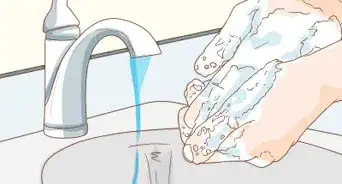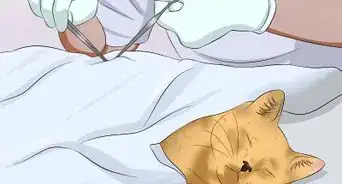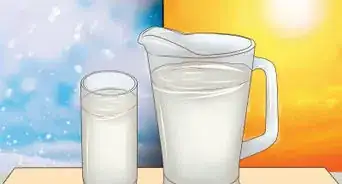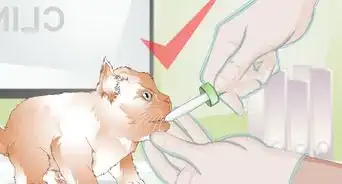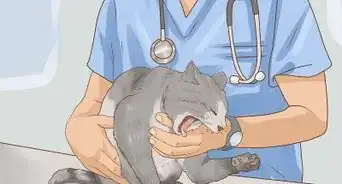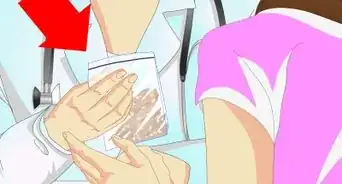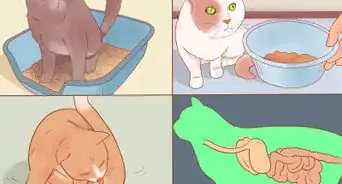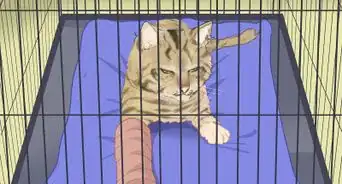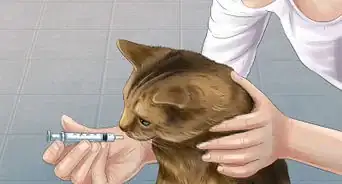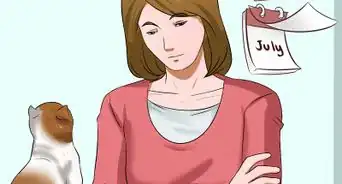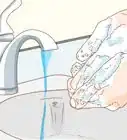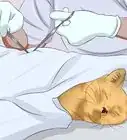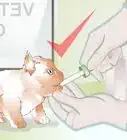This article was co-authored by Jean Johnson. Jean Johnson is a Cat Specialist and a writer for the KittyNook Blog. Jean specializes in providing advice on cat health, play, and general information about cats and cat breeds.
wikiHow marks an article as reader-approved once it receives enough positive feedback. In this case, 90% of readers who voted found the article helpful, earning it our reader-approved status.
This article has been viewed 316,554 times.
When the amount of fluid lost from a cat's body is greater than the amount taken in, the pet becomes dehydrated. This can happen for a number of reasons, including not eating or drinking enough, overheating, vomiting, diarrhea, as well as many others factors.[1] Dehydration is a serious condition for cats because proper fluid balance is critical for maintaining body temperature, removing wastes, maintaining proper circulation, and ensuring the balance of critical body systems. The sooner you can detect early signs of dehydration in your cat and get your pet appropriate help, the easier the condition is to reverse.
Steps
Checking for Signs of Dehydration
-
1Take immediate action if necessary. Some causes warrant immediate medical attention in any cat no matter his age or general health status. These causes include as any suspicion of internal bleeding, burns, moderate to severe wounds, significant or prolonged vomiting or diarrhea, lack of appetite that lasts for more than 24 hours in an adult cat or 12 hours in a young kitten, open-mouth breathing, or high fever.[2]
-
2Monitor your cat's water intake. In its early stages, dehydration is easy to miss. In fact, even the most subtle physical signs aren't detectable until the cat is at least 4 or 5% dehydrated.[3] Because of how subtle the signs are, you should pay attention to how much your cat drinks every day. Notice if he is drinking less or none at all.[4]
- You should also make sure you keep plenty of fresh water around for him, especially if you are going to be away for an extended period of time, such as work or all day outing.
Advertisement -
3Assess the gums' moistness. One way to tell if your cat is dehydrated is to check his gums. Use your finger to push up his upper lip and expose his gum line. Touch your finger to the gum. In a well-hydrated cat, the gum tissue should feel moist. As the cat becomes more and more dehydrated, his gums start to dry. If the gum tissue feels sticky or tacky, the cat may be showing the first signs of dehydration.[5]
- If the gum tissue actually feels dry, the cat may be moderately or severely dehydrated, depending on other signs. Gums usually don't feel completely dry until a cat is at least 6 to 7% dehydrated.[6]
- Keep in mind that your cat's gums will rapidly dry in the air after you raise the upper lip, so you need to assess moistness immediately.
- If your cat's gums feel dry, sticky, or tacky or you aren't certain whether or not the gums are normal, examine the cat further to help you decide whether the pet is dehydrated or how dehydrated he is.
-
4Check the gums' capillary refill time (CRT). The CRT is the amount of time it takes the capillaries, which are tiny blood vessels, in the gums to refill with blood. Because dehydration reduces blood volume, this time is increased in dehydrated pets.[7] To check CRT, press your finger to the cat's gum and release it. The skin should blanch or turn white. If it doesn't, try again and press a little harder. After you lift your finger, count the number of seconds it takes the blanched skin to return to its normal color.
- In a healthy, well-hydrated cat, the skin should return to normal color in less than 2 seconds.
- In a moderately dehydrated cat, this may take slightly longer. In cases of more severe dehydration, this refill time may be even more noticeably prolonged.
- CRT does not usually increase in cases of mild dehydration, so an increased CRT may indicate moderate to severe dehydration and warrants veterinary attention.
- If the gums are very pale or white before you press on them, take the cat to the vet right away. Pale gums can be a sign of more advanced dehydration.[8]
-
5Test skin elasticity. Another early sign of dehydration is a subtle loss of skin elasticity. This becomes more pronounced as dehydration worsens. Check elasticity by choosing an area of skin along your cat's back or chest. Avoid the skin on the back of the neck since it is thick and may give misleading results. Gently pinch the skin between two of your fingers and release it. Observe the skin you pinched.
- In a healthy, well-hydrated cat, the skin should snap back into place immediately. In a mildly dehydrated cat, the skin may not snap back into place as quickly as it would in a well-hydrated animal.[9]
- In a moderately to severely dehydrated cat, the skin will be obviously slow in returning to place, and in a profoundly dehydrated cat, the skin may stay in the pinched position instead of snapping back into place.[10]
- It is important to realize that this test is not always completely accurate. Old or emaciated animals often have less elastic skin than younger animals, so their skin may not snap into place quickly even if they are well hydrated.[11] Kittens under 6 weeks of age have less skin elasticity than adult cats. Overweight pets have a lot of subcutaneous fat, so they may not have obvious loss of skin elasticity until they are severely dehydrated.[12]
-
6Check the eyes. Your cat's eyes can give you important information about hydration status. Slightly sunken eyes in an otherwise healthy cat can signal moderate dehydration.[13] It is important to note, however, that very thin cats, especially older cats or those with chronic illnesses, may have slightly sunken eyes normally.[14]
- Severely sunken eyes that appear dry can indicate severe dehydration. In some advanced cases, the third eyelid may even be visible.[15]
- If the eyes appear dry, sunken or the third eyelid is protruding, the cat should receive prompt veterinary attention.
-
7Feel the paws. In a cat with other signs of dehydration, paws that feel cool to the touch can indicate moderate to severe dehydration.[16] To assess this, gently pick up your cat. Hold his paw in the palm of your hand and note the temperature. If it feels like the normal temperature of your cat, then he is not moderately dehydrated. If his paws feel cool or cold, this could be a sign of severe dehydration and you should get him to the vet as soon as you can.
Seeking Treatment and Evaluation
-
1Seek veterinary assistance. If your cat is showing signs of dehydration, you need to make a visit to the veterinarian.[17] You should consult a veterinarian as soon as your cat exhibits signs of dehydration, since the condition is far easier to correct in its earliest stages. If you suspect your cat is moderately to severely dehydrated, or if the animal is lethargic or unresponsive, get your pet to the veterinarian right away.
- Let the vet know it is an emergency so you can be seen faster. Severe dehydration is a life-threatening emergency.
- In addition to confirming the results of your physical examination and assessing your cat's history, your veterinarian can run tests to help determine how dehydrated your cat is and to decide on an appropriate course of treatment.
-
2Let the vet run tests. In addition to a physical examination, your vet may run some basic tests to access the state of your cat's dehydration. Some basic tests veterinarians use to assess hydration include a blood test to assess the packed cell volume (PCV). If the PCV will be higher than normal, your cat is likely dehydrated.[18]
- The vet may also run a urine sample to check its concentration. Usually, when animals are dehydrated, the kidneys concentrate urine to conserve water. If your cat has kidney disease or a hormone imbalance, however, he may not be able to appropriately concentrate his urine even when he is dehydrated.[19]
- Other tests can be run depending on the suspected underlying cause of the dehydration.
-
3Give your cat the treatment. Once the veterinarian assesses your cat, she will calculate the approximate degree of dehydration and formulate a fluid treatment plan. The best way to correct moderate to severe dehydration is by providing intravenous fluids. You also will need to address the underlying cause of the dehydration in your cat in order to remedy the situation in the future.
- In cases of severe dehydration, immediate, aggressive intravenous fluid therapy is required to ensure the cat's recovery.
-
4Look for underlying causes in sick cats. Because early signs of dehydration are subtle and easy to miss, being able to identify potential dehydration risk factors and situations that could lead to dehydration in your cat is important. You should look for common underlying causes of dehydration such as not eating or drinking enough, excessive urination, vomiting, diarrhea, burns or other skin damage, internal or external bleeding, fever, and loss of fluid inside the body due to internal bleeding or other inappropriate shift of fluid out of the blood vessels.
- Sick or debilitated cats and young kittens are especially vulnerable to this condition. If your cat fits this description, you should be especially vigilant in looking for these factors. These are always cause for alarm and warrant veterinary attention. [20]
-
5Identify risk factors. Certain medical and environmental conditions make dehydration more likely, so pets suffering from these conditions are at increased risk of becoming dehydrated. This means you should watch pets with these conditions very closely for early signs of dehydration. Examples of such conditions include kidney disease, diabetes, hyperthyroidism, heart disease, inflammatory bowel disease, gastrointestinal parasites, various infectious diseases, and heat exhaustion.
Expert Q&A
-
QuestionMy cat has sunken eyes, is not eating, and has a bloated belly and cool paws. What can be done?
 Pippa Elliott, MRCVSDr. Elliott, BVMS, MRCVS is a veterinarian with over 30 years of experience in veterinary surgery and companion animal practice. She graduated from the University of Glasgow in 1987 with a degree in veterinary medicine and surgery. She has worked at the same animal clinic in her hometown for over 20 years.
Pippa Elliott, MRCVSDr. Elliott, BVMS, MRCVS is a veterinarian with over 30 years of experience in veterinary surgery and companion animal practice. She graduated from the University of Glasgow in 1987 with a degree in veterinary medicine and surgery. She has worked at the same animal clinic in her hometown for over 20 years.
Veterinarian Sunken eyes can be the result of weight loss and/or dehydration, whilst cool paws suggests the cat has poor circulation or is very sick. Coupled with the lack of appetite and swollen belly, it's unlikely that the cat's symptoms are going to resolve on their own. She needs to see a vet in order to get to the bottom of her problem and see what treatment options are open to you.
Sunken eyes can be the result of weight loss and/or dehydration, whilst cool paws suggests the cat has poor circulation or is very sick. Coupled with the lack of appetite and swollen belly, it's unlikely that the cat's symptoms are going to resolve on their own. She needs to see a vet in order to get to the bottom of her problem and see what treatment options are open to you. -
QuestionWhat should I do if my cat passes out?
 Pippa Elliott, MRCVSDr. Elliott, BVMS, MRCVS is a veterinarian with over 30 years of experience in veterinary surgery and companion animal practice. She graduated from the University of Glasgow in 1987 with a degree in veterinary medicine and surgery. She has worked at the same animal clinic in her hometown for over 20 years.
Pippa Elliott, MRCVSDr. Elliott, BVMS, MRCVS is a veterinarian with over 30 years of experience in veterinary surgery and companion animal practice. She graduated from the University of Glasgow in 1987 with a degree in veterinary medicine and surgery. She has worked at the same animal clinic in her hometown for over 20 years.
Veterinarian In the short term, make sure the cat is safe and in no danger of falling downstairs or lying against a heater. If you can, video the unconscious cat as this could give the vet valuable clues as to what's wrong. Keep the cat warm and try to stress them as little as possible. The reason for the faints needs to be identified, which means a visit to the vet, blood pressure measurements, and blood tests to look for underlying problems.
In the short term, make sure the cat is safe and in no danger of falling downstairs or lying against a heater. If you can, video the unconscious cat as this could give the vet valuable clues as to what's wrong. Keep the cat warm and try to stress them as little as possible. The reason for the faints needs to be identified, which means a visit to the vet, blood pressure measurements, and blood tests to look for underlying problems.
References
- ↑ Helio A. de Morias, Dennis J. Chew, Catherine W. Cohn and Stephen P. DiBartola, "Disorders of Fluid Balance, Fluid Therapy and Transfusion Therapy." In Quick Reference to Veterinary Medicine, Edited by William R. Fenner. Philadelphia: Lippincott Williams & Wilkins, 2000
- ↑ Helio A. de Morias, Dennis J. Chew, Catherine W. Cohn and Stephen P. DiBartola, "Disorders of Fluid Balance, Fluid Therapy and Transfusion Therapy." In Quick Reference to Veterinary Medicine, Edited by William R. Fenner. Philadelphia: Lippincott Williams & Wilkins, 2000
- ↑ http://www.merckvetmanual.com/mvm/emergency_medicine_and_critical_care/fluid_therapy/the_fluid_resuscitation_plan.html
- ↑ Jean Johnson. Cat Expert.
- ↑ Jean Johnson. Cat Expert.
- ↑ http://www.merckvetmanual.com/mvm/emergency_medicine_and_critical_care/fluid_therapy/the_fluid_resuscitation_plan.html
- ↑ Victoria Aspinall and Richard Aspinall. Clinical Procedures in Small Animal Veterinary Practice. Gloucester, UK: 2013.
- ↑ Victoria Aspinall and Richard Aspinall. Clinical Procedures in Small Animal Veterinary Practice. Gloucester, UK: 2013.
- ↑ Jean Johnson. Cat Expert.
- ↑ http://www.veterinarypartner.com/Content.plx?P=A&A=292&S=0&EVetID=0
- ↑ Victoria Aspinall and Richard Aspinall. Clinical Procedures in Small Animal Veterinary Practice. Gloucester, UK: 2013.
- ↑ Victoria Aspinall and Richard Aspinall. Clinical Procedures in Small Animal Veterinary Practice. Gloucester, UK: 2013.
- ↑ Jean Johnson. Cat Expert.
- ↑ http://www.merckvetmanual.com/mvm/emergency_medicine_and_critical_care/fluid_therapy/the_fluid_resuscitation_plan.html
- ↑ Victoria Aspinall and Richard Aspinall. Clinical Procedures in Small Animal Veterinary Practice. Gloucester, UK: 2013.
- ↑ Victoria Aspinall and Richard Aspinall. Clinical Procedures in Small Animal Veterinary Practice. Gloucester, UK: 2013.
- ↑ Jean Johnson. Cat Expert.
- ↑ Victoria Aspinall and Richard Aspinall. Clinical Procedures in Small Animal Veterinary Practice. Gloucester, UK: 2013.
- ↑ Victoria Aspinall and Richard Aspinall. Clinical Procedures in Small Animal Veterinary Practice. Gloucester, UK: 2013.
- ↑ Helio A. de Morias, Dennis J. Chew, Catherine W. Cohn and Stephen P. DiBartola, "Disorders of Fluid Balance, Fluid Therapy and Transfusion Therapy." In Quick Reference to Veterinary Medicine, Edited by William R. Fenner. Philadelphia: Lippincott Williams & Wilkins, 2000
- ↑ http://www.veterinarypartner.com/Content.plx?A=3041
About This Article
To check a cat for dehydration, feel its paws to see if they're cool or cold to the touch, which is a sign of moderate to severe dehydration. You should also check your cat's gums to see if they feel dry, sticky, or tacky since a dehydrated cat will have drier gums than usual. Also, examine your cat's eyes to see if they look dry or sunken or if the third eyelid is protruding, which are all signs of severe dehydration. If you think your cat is dehydrated, take it to a vet immediately for treatment. For more advice from our Veterinary co-author, like how to treat a cat that's dehydrated, scroll down.












